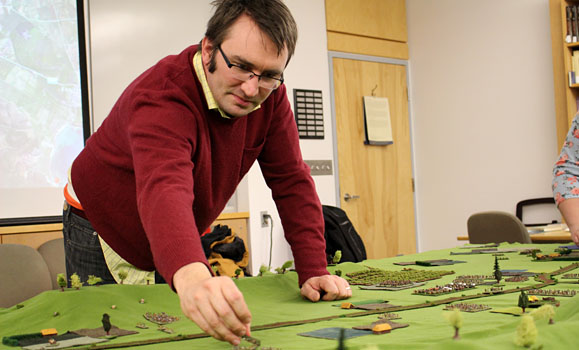It’s one thing to read about ancient battles in a textbook. It’s another thing to witness it up close — in a manner of speaking.
Students in the second-year Classics course “Roman Legions & the Barbarians” were able to get a different angle on two important historic battles this past term as the course’s instructor, Jack Mitchell, hosted students for a drop-in tutorial complete with a miniature battlefield recreation.
The large diorama, 10 feet long and six feet across, was filled with hundreds of tiny soldiers, each less than a centimetre tall. Together with the trees, wildlife, ships and villages, the armies were there to recreate the setting for two particular battles that took place in the third century BC.
The first tutorial focused on a major Roman victory — the Battle of Telamon (225 BC), between the Romans and the Gauls of the Po Valley in Northern Italy. The second tutorial highlighted the 216 BC Battle of Cannae between the Romans and the Carthaginians, under Hannibal, which the Romans lost.

Students who attended each tutorial experienced a brief introduction by Dr. Mitchell before he led the students in recreating the troop movements.
“It’s about showing the reality of the deployment of large numbers of troops in a pre-modern period,” he explained. “It’s very hard today, with our modern weapons, to imagine a war that’s all about large armies fighting with knives and swords, packed into small spaces. It’s a very different character of war. You can talk about it in class, you can show paintings and depictions, but to physically see it makes a big difference.”
There are about 100 students in the class, any many of them dropped by during the tutorials. “We start from the earliest origins of the Roman army,” says Dr. Mitchell, describing the course, “and we end with the downfall of the Byzantine Empire. Referring to this particular diorama, he noted that, “This is one of the most classic eras of the Roman army, when they’re fighting to expand the Roman Empire.”
The pieces for the diorama belong to Dr. Mitchell, who started building them with the help of his brother when they were teens. “It was a hobby of ours for some time, but we never got rid of them,” he said. “I thought, why not use them for pedagogical reasons?”

